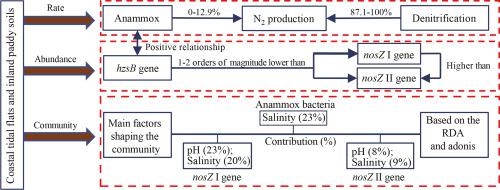当前位置:
X-MOL 学术
›
Appl. Soil Ecol.
›
论文详情
Our official English website, www.x-mol.net, welcomes your
feedback! (Note: you will need to create a separate account there.)
Rates and microbial communities of denitrification and anammox across coastal tidal flat lands and inland paddy soils in East China
Applied Soil Ecology ( IF 4.8 ) Pub Date : 2021-01-01 , DOI: 10.1016/j.apsoil.2020.103768 Bing Han , Liu-Ying Mo , Yun-Ting Fang , Hong J. Di , Jun-Tao Wang , Ju-Pei Shen , Li-Mei Zhang
Applied Soil Ecology ( IF 4.8 ) Pub Date : 2021-01-01 , DOI: 10.1016/j.apsoil.2020.103768 Bing Han , Liu-Ying Mo , Yun-Ting Fang , Hong J. Di , Jun-Tao Wang , Ju-Pei Shen , Li-Mei Zhang

|
Abstract Denitrification and anammox are the main pathways of N loss in wet habitats while their relative contribution to N2 production and underlying microbial mechanisms across marine-terrestrial ecotone remain unclear. Here we investigated the rates of anammox and denitrification, and the distribution patterns of anammox bacteria and nosZ clade I and II denitrifiers across coastal tidal flat to inland paddy soils. Results showed that denitrification dominated the N2 production over anammox in all samples, accounting for 87.1%–100% of total N2 production. Coincident with the rate, the abundance of nosZ clade I and II genes were 1–2 orders of magnitude higher than those of hzsB gene. The community of anammox bacteria was mainly driven by salinity while nosZ clade I and II denitrifiers communities were mainly determined by both salinity and pH. Alphaproteobacteria dominated in the nosZ clade I community in all samples while Betaproteobacteria and Gammaproteobacteria were mainly present in low salinity wetland and paddy soils. The nosZ clade II community was composed of more phyla, in which Bacteoidetes and Chloroflexi were ubiquitous while Gemmatimonadetes was present only in low salinity wetland and paddy soils. These findings have direct implications for explicitly incorporating both nosZ clade I and II into future N loss estimation and N2O mitigation in marine-terrestrial ecotone.
中文翻译:

华东沿海滩涂和内陆稻田反硝化和厌氧氨氧化速率和微生物群落
摘要 反硝化作用和厌氧氨氧化是潮湿生境中氮流失的主要途径,而它们对氮生成的相对贡献和跨越海陆交错带的潜在微生物机制尚不清楚。在这里,我们调查了厌氧氨氧化和反硝化的速率,以及厌氧氨氧化细菌和 nosZ 进化枝 I 和 II 反硝化菌在沿海潮滩到内陆稻田的分布模式。结果表明,在所有样品中,反硝化作用在 N2 生产中占主导地位,占 N2 总产量的 87.1%–100%。与速率一致的是,nosZ 进化枝 I 和 II 基因的丰度比 hzsB 基因高 1-2 个数量级。厌氧氨氧化细菌群落主要由盐度驱动,而 nosZ 进化枝 I 和 II 反硝化菌群落主要由盐度和 pH 决定。Alphaproteobacteria 在所有样品的 nosZ 进化枝 I 群落中占主导地位,而 Betaproteobacteria 和 Gammaproteobacteria 主要存在于低盐度湿地和稻田土壤中。nosZ clade II 群落由更多的门组成,其中 Bacteoidetes 和 Chloroflexi 无处不在,而 Gemmatimonadetes 仅存在于低盐度湿地和稻田中。这些发现对于将 nosZ 进化枝 I 和 II 明确纳入未来海陆交错带中的 N 损失估计和 N2O 减缓具有直接意义。其中 Bacteoidetes 和 Chloroflexi 无处不在,而 Gemmatimonadetes 仅存在于低盐度湿地和稻田土壤中。这些发现对于将 nosZ 进化枝 I 和 II 明确纳入未来海陆交错带中的 N 损失估计和 N2O 减缓具有直接意义。其中 Bacteoidetes 和 Chloroflexi 无处不在,而 Gemmatimonadetes 仅存在于低盐度湿地和稻田土壤中。这些发现对于将 nosZ 进化枝 I 和 II 明确纳入未来海陆交错带中的 N 损失估计和 N2O 减缓具有直接意义。
更新日期:2021-01-01
中文翻译:

华东沿海滩涂和内陆稻田反硝化和厌氧氨氧化速率和微生物群落
摘要 反硝化作用和厌氧氨氧化是潮湿生境中氮流失的主要途径,而它们对氮生成的相对贡献和跨越海陆交错带的潜在微生物机制尚不清楚。在这里,我们调查了厌氧氨氧化和反硝化的速率,以及厌氧氨氧化细菌和 nosZ 进化枝 I 和 II 反硝化菌在沿海潮滩到内陆稻田的分布模式。结果表明,在所有样品中,反硝化作用在 N2 生产中占主导地位,占 N2 总产量的 87.1%–100%。与速率一致的是,nosZ 进化枝 I 和 II 基因的丰度比 hzsB 基因高 1-2 个数量级。厌氧氨氧化细菌群落主要由盐度驱动,而 nosZ 进化枝 I 和 II 反硝化菌群落主要由盐度和 pH 决定。Alphaproteobacteria 在所有样品的 nosZ 进化枝 I 群落中占主导地位,而 Betaproteobacteria 和 Gammaproteobacteria 主要存在于低盐度湿地和稻田土壤中。nosZ clade II 群落由更多的门组成,其中 Bacteoidetes 和 Chloroflexi 无处不在,而 Gemmatimonadetes 仅存在于低盐度湿地和稻田中。这些发现对于将 nosZ 进化枝 I 和 II 明确纳入未来海陆交错带中的 N 损失估计和 N2O 减缓具有直接意义。其中 Bacteoidetes 和 Chloroflexi 无处不在,而 Gemmatimonadetes 仅存在于低盐度湿地和稻田土壤中。这些发现对于将 nosZ 进化枝 I 和 II 明确纳入未来海陆交错带中的 N 损失估计和 N2O 减缓具有直接意义。其中 Bacteoidetes 和 Chloroflexi 无处不在,而 Gemmatimonadetes 仅存在于低盐度湿地和稻田土壤中。这些发现对于将 nosZ 进化枝 I 和 II 明确纳入未来海陆交错带中的 N 损失估计和 N2O 减缓具有直接意义。











































 京公网安备 11010802027423号
京公网安备 11010802027423号